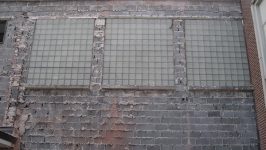CONNECTORS, ANCHORS and FASTENERS
By Paul Potts
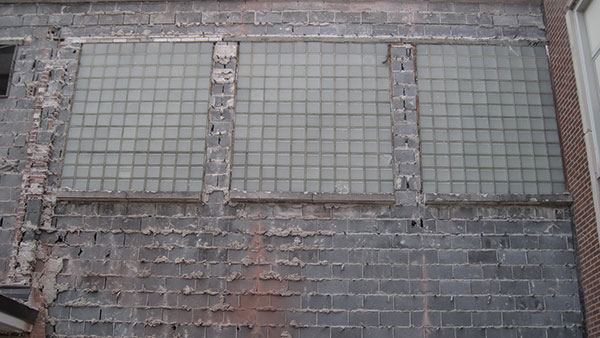
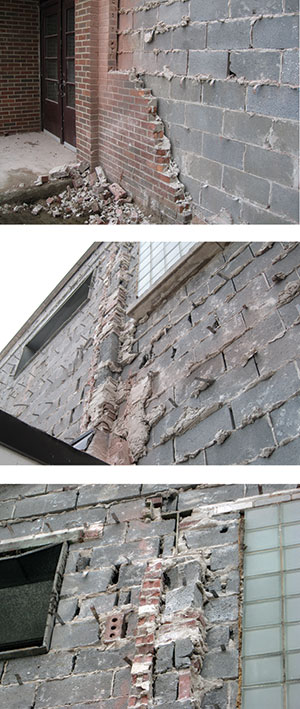
In 2011, the Homer, Mich., school district began a building project. The plans included the construction of a new high school/middle school adjoining the existing K–8 building, demolition of the old high school and replacement of the existing brick veneer with masonry matching the new high school.
Stripping the brick veneer from the north elevation of the old middle school gym was ongoing when I arrived at the site on a sunny spring morning in March 2013. At first sight, the exposed masonry was attention getting. There were voids in the CMU, missing head joint mortar, and poorly constructed structural piers built from pieces of block and leftover brick mixed with copious amounts of mortar supporting the roof beam.
There were no weep holes and no drainage cavity. There were no control joints in either the interior or exterior width. And, while there were flat metal ties sticking out from the CMU joints for connecting the brick to the block, the missing joint mortar and broken block made the CMU width seem lacking in horizontal strength.
It appeared that the exterior bearing walls were intended as composite construction that would have required parged CMU faces or a full grout collar joint between courses, but there was no evidence of parging, and the gap was filled with mortar only sporadically. Any moisture that had gotten through the brick veneer would have been absorbed by the CMU, causing freeze-thaw cycling.
Indeed, the deterioration of the CMU was attention getting, but the condition of the masonry piers that supported the I-beam holding up the roof structure was more serious. Expert evaluation and advice were needed.
When I reached Scott Wilmot, the field construction manager for Wolgast Corp., we discussed suspending the veneer removal altogether, but the decision was reached to proceed with added caution.
After consulting with both Scott and Jeff Bates, project manager for Wolgast Corp., I took some photos and prepared a report for the structural engineer, Bert Sherman at Teton Design.
The school district’s construction budget was mostly committed, except for a contingency of $225,000. That was not enough to build a new gym. The fact that a new roof had been put on the gym two years earlier would also weigh on the decision.
The gym was supposed to reopen the following school year. That was only seven months away. So, we were working with a limited budget and a tight schedule.
I sent the report and photos to Bert and gave him a call. We discussed the condition of the structure and concluded we needed a masonry expert to help with the evaluation and recommendations. We agreed that Scott Walkowicz, of Michigan Structural Masonry Coalition, was right for the job.
I had confidence that Scott Walkowicz was the expert we wanted. I had worked with him previously on the evaluation of settlement at St. Paul’s Episcopal Church, a historic building across from the Capitol in Lansing, Mich.
Bert and Scott arrived the next day and, joined by Scott Wilmot, they examined the exposed CMU wall. I discussed the schedule and the owner’s budget with them. After surveying the entire building, they reported there were solutions within our budget, but it would use up most of the remaining contingency.
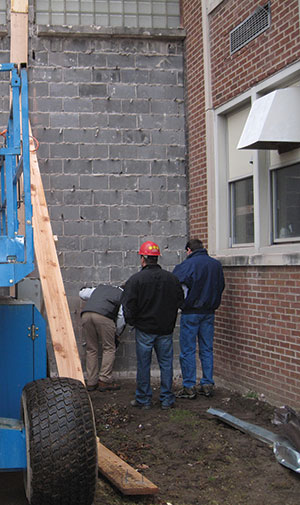
When Bert called a few days later, he said we could choose from two recommendations to resupport the existing masonry:
- Build a structural steel frame and metal stud infill to anchor and support the existing masonry.
OR - Build a new masonry cavity wall of CMU and brick veneer on a new foundation and connect it to the existing CMU masonry.
Bert said he had no preference for either solution — it was more a matter of schedule and cost — but he needed a few days to put together documentation on the two designs. Including circulation and time and getting prices, the whole process would take up to a week.
The ready availability of the masonry contractor became a factor in selecting between solutions. There was already a reliable contractor, Zimmerman Masonry, actively working on the site that could mobilize right away, but there was no steel contractor similarly available on short notice. The steel solution would probably have advanced the schedule a bit more quickly once the work got under way, but that single positive factor was not enough to sway everyone. Also, the likelihood that the masonry solution would be cheaper, according to the construction manager’s estimates, would probably close the deal.
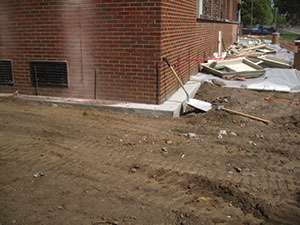
A meeting with the superintendent of schools was arranged for the next week to put the plans before him. The meeting ended pretty quickly; both the owner and the construction manager opted for the masonry solution. It involved a known cost, because Zimmerman had already submitted their price, and soliciting the steel bids would have set the project back several weeks. The comfort in making this decision was aided by our acquaintance with Zimmerman Masonry.
The steel solution would still have to be used on the west elevation, where the gym connected with classrooms and the existing veneer sat on a steel angle brick ledge above the adjacent roof.
Bert’s design required construction of a new cavity wall of CMU and brick veneer on an extended foundation connected with dowels to the old foundation. The new masonry would have a drainage cavity, insulation, mortar net, weep holes, control joints, and horizontal and vertical reinforcement.
The new wall would be reinforced with vertical #5 rebar at 32 inches on center, except the window piers would have a rebar at 8 inches on center. The new CMU was reinforced with multi-width, truss-type, horizontal reinforcement at every other course, with hook-and-eye connectors for attaching the brick veneer.
The design provided for connection of the new wall to the existing wall with triangular adjustable wall ties similar to a Wire-Bond Type 3 at 16 inches on center in both directions, the plate anchored to the existing CMU with two 1/4-inch, hex-head stainless steel Tapcon anchors. The wall tie would provide a secure connection between the old and new masonry, adjust to the variable distance in the cavity and allow for differential movement.
There were other complications that became apparent as the work progressed.
The old masonry was 3–4-inches out of plumb from top to bottom, which would result in a gap of varying dimensions between the two courses of CMU, and require additional work at the window and door openings. One thing was certain: the added wall, at 24 inches thick, would lower the district’s heating bills.
The top of the gym parapet was 7 inches out of level from the northwest to the northeast corner. A new metal frame parapet would correct for that, but it would require an extension of the roofing to cover the increased parapet — another added cost. Also, the windows in the north elevation were 8 inches higher than the openings in the east elevation. The fact that the windows were not level was hardly noticeable before the parapet was corrected, but once that was done, it was obvious there was a lot of work to do on the window openings. I was glad we had Zimmerman Masonry working with us.
The roof beam that had been so precariously supported on a faulty masonry pier was now supported on an 8-inch square steel tube. It was reassuring to see when it was finally in place.
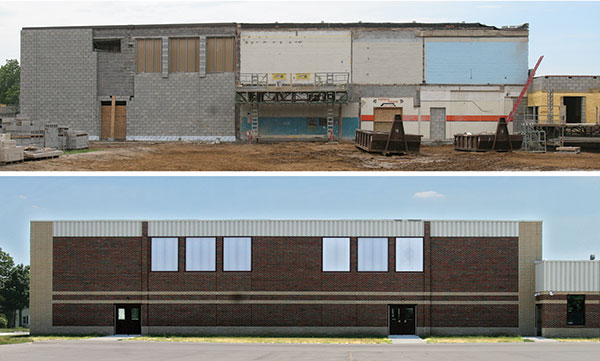
As already stated, the window openings in the north elevation were 8 inches higher than the windows in the east elevation. The architect insisted — and rightly so — that the window openings match. It was easy with masonry to remove one block from the sills in the north openings to lower them 8 inches, but the head was a little more complicated. On the outside, the new metal fascia panel covered the new metal framing, but the inside required masonry soaps set on a lintel attached to the metal framing to provide masonry for painting. Fortunately, the gym was scheduled to be painted under the original contract.
None of repairs that were ultimately deemed necessary could have been ascertained by looking at the building before the veneer was removed. The physical appearance was entirely deceptive. It looked substantial from both the inside and the outside. In the future, I will pay more attention to older buildings that don’t have weep holes or control joints. This can be a hint there are other shortcomings that are not visible.
The Homer School Construction Program provided a new high school/middle school addition and significant improvements to all of the campus buildings. The construction team members — Homer Community Schools, Kingscott Associates, Wolgast Corp. and Zimmerman Masonry — were proud to play a part in providing the community with an improved image of their school buildings…and a safer one, too.
Paul Potts writes for the design and construction industry. He has worked as a construction administrator for architects and engineers and owner’s representative during construction. Potts can be contacted at paulpotts1@comcast.net.
